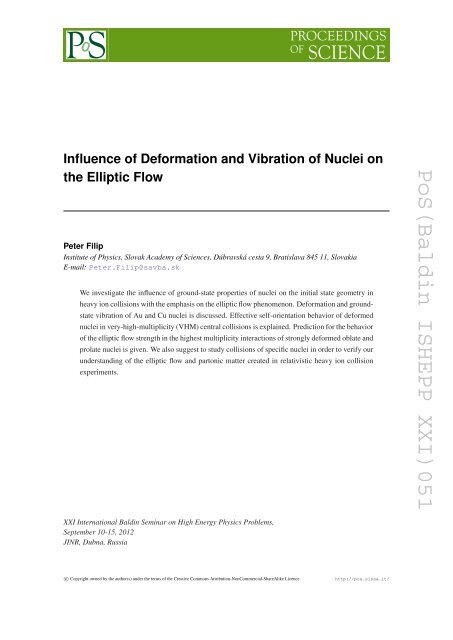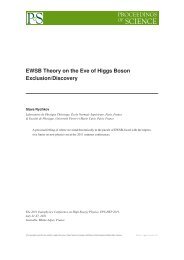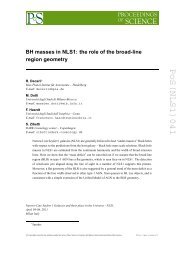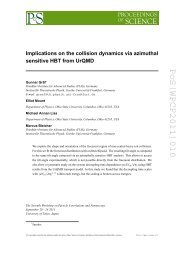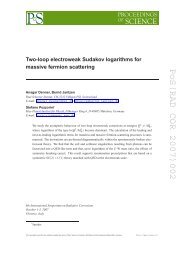Baldin ISHEPP XXI_051.pdf - Sissa.it
Baldin ISHEPP XXI_051.pdf - Sissa.it
Baldin ISHEPP XXI_051.pdf - Sissa.it
You also want an ePaper? Increase the reach of your titles
YUMPU automatically turns print PDFs into web optimized ePapers that Google loves.
Influence of Deformation and Vibration of Nuclei on<br />
the Elliptic Flow<br />
Peter Filip<br />
Inst<strong>it</strong>ute of Physics, Slovak Academy of Sciences, Dúbravská cesta 9, Bratislava 845 11, Slovakia<br />
E-mail: Peter.Filip@savba.sk<br />
We investigate the influence of ground-state properties of nuclei on the in<strong>it</strong>ial state geometry in<br />
heavy ion collisions w<strong>it</strong>h the emphasis on the elliptic flow phenomenon. Deformation and groundstate<br />
vibration of Au and Cu nuclei is discussed. Effective self-orientation behavior of deformed<br />
nuclei in very-high-multiplic<strong>it</strong>y (VHM) central collisions is explained. Prediction for the behavior<br />
of the elliptic flow strength in the highest multiplic<strong>it</strong>y interactions of strongly deformed oblate and<br />
prolate nuclei is given. We also suggest to study collisions of specific nuclei in order to verify our<br />
understanding of the elliptic flow and partonic matter created in relativistic heavy ion collision<br />
experiments.<br />
PoS(<strong>Baldin</strong> <strong>ISHEPP</strong> <strong>XXI</strong>)051<br />
<strong>XXI</strong> International <strong>Baldin</strong> Seminar on High Energy Physics Problems,<br />
September 10-15, 2012<br />
JINR, Dubna, Russia<br />
c○ Copyright owned by the author(s) under the terms of the Creative Commons Attribution-NonCommercial-ShareAlike Licence.<br />
http://pos.sissa.<strong>it</strong>/
Elliptic flow and Deformation of Nuclei<br />
1. Introduction<br />
In heavy ion collision experiments, ground-state deformation of nuclei is usually believed to be<br />
the unnecessary complication and spherical nuclei are preferred for such experiments. However,<br />
if the highest possisble baryonic or energy dens<strong>it</strong>ies are required, and when nuclei significantly<br />
heavier than 208 Pb are accelerated (collided), the prolate deformation has to be taken into account.<br />
Moreover, vast major<strong>it</strong>y of nuclei are slightly deformed, including Au and In collided at RHIC/BNL<br />
and SPS/CERN and one can ask, how much the quant<strong>it</strong>ies (e.g. J/Ψ suppression) evaluated w<strong>it</strong>h<br />
the assumption of spherical shape of such nuclei can be affected.<br />
Although the Elliptic flow in Au+Au collisions measured by RHIC detectors at Brookhaven<br />
National Laboratory seems to be well understood there still remain some issues to be explained.<br />
For example, strength of the elliptic flow measured in Cu+Cu collisions [1] at RHIC is 2x larger<br />
than predictions from our models. Is our understanding of in the in<strong>it</strong>ial state of QCD matter in<br />
Cu+Cu collision incomplete or is there some physics being neglected in our models of the partonic<br />
matter expansion?<br />
In this contribution we discuss, why deformation and ground-state vibration of nuclei affects<br />
the in<strong>it</strong>ial eccentric<strong>it</strong>y of the interaction volume. Possible influence of short-range-correlations<br />
(SRC) of nucleons in some nuclei is briefly skeched and specific collision systems are suggested.<br />
2. Intrinsic deformation and vibration of nuclei<br />
Major<strong>it</strong>y of nuclei posess the intrinsic quadrupole deformation as a consequence of spontaneous<br />
symmetry breaking in the ground-state of rotationaly invariant hamiltonian [2]. Spectroscopic<br />
quadrupole moments Q(s z ) of nuclei observed in NMR spectra are related to the intrinsic<br />
quadrupole moment Q o via formula: Q(s z ) = Q o [3s 2 z − J(J + 1)]/[(J + 1)(2J + 3)], which gives<br />
e.g. Q(1/2)>0 while Q o < 0 for 197 Au (J=3/2) nucleus and always yields Q = 0 for J = 0 nuclei.<br />
Indeed, <strong>it</strong> is well known, that 154 Sm and many other rare-earth nuclei [3] are strongly deformed<br />
β 2 ≈ 0.27 while having zero spin J = 0 (see 150 Nd in Fig.2 and 154 Sm in Fig.6).<br />
2<br />
| Ψ |<br />
0.6<br />
0.5<br />
0.4<br />
0.3<br />
0.2<br />
0.1<br />
0<br />
oblate<br />
prolate<br />
0.4 0.3 0.2 0.1 0 0.1 0.2<br />
Figure 1: Probabil<strong>it</strong>y of vibrating oblate nucleus to<br />
have deformation given by fluctuating β 2 parameter.<br />
β<br />
2<br />
Nd142<br />
Nd150<br />
Figure 2: 142 Nd and 150 Nd nuclei.<br />
PoS(<strong>Baldin</strong> <strong>ISHEPP</strong> <strong>XXI</strong>)051<br />
Besides the static quadrupole intrinsic deformation, the shape of nuclei may vibrate in their<br />
lowest energy state due to the quantum zero-point vibartional energy [4]. In molecular physics,<br />
2
Elliptic flow and Deformation of Nuclei<br />
quantum vibrations are well understood and the ampl<strong>it</strong>ude of ground-state shape vibrations of C 60<br />
molecule was calculated [5]. Also, for muonic heavy hydrogen molecule, vibrational wave function<br />
of the ground state needs to be known for estimating the fusion probabil<strong>it</strong>y [6] in such system.<br />
If nuclear shape vibrations are large enough they can effectively generate dynamical quadrupole<br />
moment even for almost spherical β 2 ≈0 nuclei [7]. In Fig.1 we show how large quadrupole vibrations<br />
we may expect in the ground state of 196 Hg nucleus according to [8]. Such dynamical<br />
deformation effects have not been taken into account in the in<strong>it</strong>ial eccentric<strong>it</strong>y simullation [9].<br />
In<strong>it</strong>ial overlap time τ i for relativistic collisions of nuclei is much shorter then period of zeropoint<br />
shape vibrations (1/ν), and one can consider dynamic vibrational state to be frozen during<br />
the collision. All deformation values β 2 below the curve shown in Fig.1 have to be taken into<br />
account w<strong>it</strong>h the corresponding probabil<strong>it</strong>y. In the next section we discuss how static deformation<br />
can influence the average eccentric<strong>it</strong>y of the interaction zone in ultra-central collisions.<br />
3. Eccentric<strong>it</strong>y in collisions of deformed nuclei<br />
Spatial orientation of deformed nuclei colliding at given impact parameter directly affects the<br />
total charge multiplic<strong>it</strong>y dN ch /dη and in<strong>it</strong>ial eccentric<strong>it</strong>y ε 2 of the interaction zone on event-byevent<br />
basis. Strongly exagerated effect is shown in Fig.3. Assuming two-component model for<br />
particle production [10]<br />
dN ch /dη = (1 − x) · n pp<br />
N part<br />
2<br />
+ x · n pp N coll (3.1)<br />
one has larger multiplic<strong>it</strong>y dN ch /dη due to significantly higher number of binary nucleon-nucleon<br />
collisions N coll for long<strong>it</strong>udinaly oriented prolate nuclei colliding at zero impact parameter if compared<br />
to other possible orientations. Selecting central collisions of prolate nuclei w<strong>it</strong>h very-highmultiplic<strong>it</strong>y<br />
(VHM) one effectively enhances the fraction of events w<strong>it</strong>h long<strong>it</strong>udinaly oriented<br />
nuclei in such data sample, which corresponds to the effective "self-orientation".<br />
long<strong>it</strong>udinal orientation<br />
+ +<br />
N coll<br />
= 4<br />
N coll<br />
= 16<br />
Figure 3: Number of nucleon-nucleon collisions for different<br />
orientations of two extremely prolate nuclei.<br />
Figure 4: 165 Ho, 116 Cd shapes.<br />
It has been speculated [11] that sample of central Au+Au collisions studied at RHIC/BNL<br />
may contain a small admixture of events w<strong>it</strong>h anomalously large (single-event) elliptic flow values.<br />
Such events could be understood as central collisions of su<strong>it</strong>ably oriented non-spherical Au<br />
nuclei. Indeed, spectroscopic quadrupole moment of Au nucleus Q=+0.58 [12] confirms the nonspheric<strong>it</strong>y<br />
of 197 Au charge distribution. Also theoretical calculations [3] predict 197 Au to be have<br />
oblate deformation (β 2 = −0.13), which has been confirmed by recent GDR measurements [13].<br />
Strongly deformed oblate nucleus 116 Cd w<strong>it</strong>h β 2 = −0.24 [3] is shown in Fig.4 next to the prolate<br />
PoS(<strong>Baldin</strong> <strong>ISHEPP</strong> <strong>XXI</strong>)051<br />
3
Elliptic flow and Deformation of Nuclei<br />
nucleus 165 Ho. It is clear, that for collisions of oblate nuclei the highest multiplic<strong>it</strong>y is obtained<br />
when the main symmetry axis of nuclei is oriented orthogonally to the beam and parallel to each<br />
other. Number of binary nucleon-nucleon collisions N coll is the highest in this case, giving the<br />
largest multiplic<strong>it</strong>y of produced particles (see Eq.3.1). At the same time in<strong>it</strong>ial eccentric<strong>it</strong>y ε 2 in<br />
such collisions is rising proportionaly to the strength of the oblate deformation β 2 < 0. Thus oblateness<br />
of Au nucleus could explain admixture of events w<strong>it</strong>h anomalously large elliptic flow values in<br />
the sample of central Au+Au collisions. Ground state wave function of 197 Au nucleus is however<br />
not precisely known, due to the odd number of protons Z = 79. It is not clear how much 197 Au<br />
nucleus vibrates in <strong>it</strong>s ground state compared to 196 Hg (see Fig.1).<br />
For collisions of prolate nuclei a sudden drop (cusp) in the in<strong>it</strong>ial eccentric<strong>it</strong>y for the highest<br />
multiplic<strong>it</strong>y (VHM) collisions has been predicted [9]. Indeed, the in<strong>it</strong>ial eccentric<strong>it</strong>y suddenly<br />
decreases if prolate nuclei oriented long<strong>it</strong>udinally collide at very small impact parameters. This<br />
prediction [9] is based on the model of charged particle multiplic<strong>it</strong>y production [10] (see Eq.3.1),<br />
which may be slightly different from the real particle production mechanism. Add<strong>it</strong>ionally, a<br />
high multiplic<strong>it</strong>y tail of Poissonian (or negative-binomial) distribution from the more frequent<br />
randomly oriented collisions w<strong>it</strong>h smaller average 〈dN ch /dη〉 can contaminate substantially the<br />
sample of VHM collisions. Therefore, anticipated cusp-like decrease of the elliptic flow value at<br />
high-multiplic<strong>it</strong>y tail of central collisions of prolate nuclei [9] needs to be verified experimentally.<br />
ε 2<br />
In<strong>it</strong>ial Eccentric<strong>it</strong>y (participant plane)<br />
0.8<br />
0.7<br />
0.6<br />
0.5<br />
0.4<br />
0.3<br />
0.2<br />
0.1<br />
0<br />
−0.1<br />
154 154<br />
Sm + Sm<br />
0 100 200 300 400 500 600<br />
dNch/dη<br />
Figure 5: Eccentric<strong>it</strong>y[Nch] plot for 154 Sm + 154 Sm collisions<br />
obtained from the Optical Glauber Model [14] simulation.<br />
Figure 6: 154 Sm nucleus.<br />
In Fig.5 we show the result of Optical Glauber simulation [14] for the in<strong>it</strong>ial eccentric<strong>it</strong>y ε 2 as a<br />
function of charged multiplic<strong>it</strong>y for collisions of strongly deformed 154 Sm nuclei. The cusp-like decrease<br />
of the average in<strong>it</strong>ial eccentric<strong>it</strong>y is located in the multiplic<strong>it</strong>y region 500 < dN ch /dη < 600<br />
where effective orientation of prolate nuclei happens. It is also clear, that eccentric<strong>it</strong>y fluctuations<br />
are large at given dN ch /dη due to deformation. For spherical 144 Sm+ 144 Sm collisions the Optical<br />
Glauber Model [14] gives just a single value of eccentric<strong>it</strong>y ε 2 at given dN ch /dη. Full Monte Carlo<br />
Glauber simulation [9] generates fluctuating eccentric<strong>it</strong>ies even for spherical nuclei.<br />
In collisions<br />
√<br />
of deformed nuclei, width σ v2 of the elliptic flow fluctuation should increase as<br />
σ v2 ≈ λ · ˜σ ε 2 + σβ 2 , where ˜σ ε is the eccentric<strong>it</strong>y fluctuation present also for spherical nuclei colli-<br />
5<br />
0<br />
5<br />
PoS(<strong>Baldin</strong> <strong>ISHEPP</strong> <strong>XXI</strong>)051<br />
4
Elliptic flow and Deformation of Nuclei<br />
sions (originating from all other sources exept a static deformation), and σ β denotes the eccentric<strong>it</strong>y<br />
fluctuation width due to β 2 deformation of nuclei. Factor λ ≈ 0.2 comes from the hydrodynamic<br />
simulations of the partonic matter expansion. Experimental verification of the above mentioned<br />
effects would convince heavy ion commun<strong>it</strong>y, that our understanding of the in<strong>it</strong>ial eccentric<strong>it</strong>y and<br />
the elliptic flow phenomenon are correct. In the next section we suggest carefuly selected collision<br />
systems, which may allow one to disentangle deformation effects from other physics observables<br />
of interest and verify our models of partonic matter behavior during the expansion.<br />
4. Suggested collision systems<br />
Verification of our understanding of the relation between in<strong>it</strong>ial eccentric<strong>it</strong>y and observed elliptic<br />
flow strength (and fluctuations) can be done using collisions of carefully selected nuclei w<strong>it</strong>h<br />
known properties. Very interesting might be a comparison of 144 Sm+ 144 Sm and 154 Sm+ 154 Sm collisions.<br />
Samarium element allows one to study collisions of spherical and strongly deformed nuclei<br />
in a relativistic collider using the same setup of the ion source. Another element providing us w<strong>it</strong>h<br />
the same possibil<strong>it</strong>y is Neodymium (see Fig.2). Static shape of pherical 144 Sm and prolate 154 Sm<br />
isotopes (both stable) is shown in Fig.7. Cusp-like decrease of v 2 strength in VHM central collisions<br />
of heavy 154 Sm nuclei should be observable at ultra-relativistic energies on LHC and RHIC<br />
colliders if our understanding of the mechanism of charged multiplic<strong>it</strong>y generation (see Eq.3.1) are<br />
indeed correct.<br />
Sm144<br />
Sm154<br />
Figure 7: Shape of 144 Sm and 154 Sm nuclei.<br />
5<br />
0<br />
5<br />
Ru96<br />
Zr96<br />
Figure 8: Shape of 96 Ru and 96 Zr nuclei.<br />
Another important possibil<strong>it</strong>y is to compare collisions of 96 Zr+ 96 Zr and 96 Ru+ 96 Ru nuclei<br />
which have the same mass number but their charge (proton number) differs by 10%. Different<br />
charge of these nuclei allows one to perfome testing of the sens<strong>it</strong>iv<strong>it</strong>y of various measurable quant<strong>it</strong>ies<br />
(also the elliptic flow) on the extreme (B>10 14 T) magnetic fields created for a short time<br />
by charged spectators in non-central collisions. One has to keep in mind however, that 96 Ru nucleus<br />
is almost spherical (β 2 = 0.05) while 96 Zr is prolate (β 2 = 0.22) [3]. It is therefore important<br />
to understand and subtract deformation effects (observed e.g. in 154 Sm+ 154 Sm collisions), from<br />
96 Zr+ 96 Zr observables before chiral magnetic effect [15] (strong Par<strong>it</strong>y violation) or in<strong>it</strong>ial-state<br />
isospin-dependent phenomena are claimed. Collisions of Zr+Zr and Ru+Ru nuclei have been studied<br />
succesfully by FOPI collaboration [16] at GSI.<br />
For completeness, we mention here also 116 Cd+ 116 Cd collisions as an interesting system, for<br />
studying the oblate deformation effects (rising of the elliptic flow in central VHM collisions).<br />
5<br />
0<br />
5<br />
PoS(<strong>Baldin</strong> <strong>ISHEPP</strong> <strong>XXI</strong>)051<br />
5
Elliptic flow and Deformation of Nuclei<br />
In principle, once Equation of State of hot QCD matter is known well enough, one can consider<br />
(and use) relativistic collisions of nuclei as a tool for studying of the ground-state properties<br />
(e.g. intrinsic deformation) of selected nuclei, using the observables (e.g. elliptic flow) which are<br />
sens<strong>it</strong>ive to the in<strong>it</strong>ial state.<br />
5. Unknown in<strong>it</strong>ial state effect or pre-equilibrium flow ?<br />
What kind of phenomenon is reponsible for too strong elliptic flow observed [1] in RHIC<br />
experiments w<strong>it</strong>h 63 Cu+ 63 Cu collisions? According to theoretical calculation [3] static deformation<br />
of 63 Cu is β 2 ≈ 0.16 (prolate) while 65 Cu is predicted to be oblate (β 2 ≈ −0.15). Such deformation<br />
most likely cannot generate 2x higher eccentric<strong>it</strong>y (elliptic flow) values than are expected when<br />
spherical shape of Cu nuclei is assumed in the simulations. In general, ampl<strong>it</strong>ude of zero point<br />
vibrations is larger for lighter systems (molecules) and thus vibrations of Cu nuclei may be stronger<br />
then the vibration of 196 Hg nuclei (see Fig.1). However, even the shape coexistence phenomenom<br />
(superpos<strong>it</strong>ion of obalte and prolate shapes in the ground state of nucleus) does not seem to be<br />
capable of enhancing in<strong>it</strong>ial eccentric<strong>it</strong>ies by factor 2x in the central<strong>it</strong>y region studied in [1].<br />
In fusion experiments w<strong>it</strong>h 16 O+ 63,65 Cu system [17] significant anomalies were observed for<br />
63 Cu which do not appear for 65 Cu. Is there something in the 63 Cu ground state which is not understood?<br />
Besides the vibrational properties of nuclei (which we have discussed), there exists a<br />
phenomenon of the short-range-correlation (SRC) of p-n pairs in nuclei [18], which might influence<br />
the in<strong>it</strong>ial state. In 12 C the fraction of SRC pairs [18] is estimated to be 12%. Also cumulative<br />
effects studied 30 years ago [19] indicated that wave function of 12 C nucleus and other nuclei<br />
(including Cu) contains an admixture of very dense multi-nucleon spots (fluctuons) w<strong>it</strong>h unusually<br />
high momenta. Such "hot spots" and pre-equilibrium flow phenomena originating from large<br />
(antiparallel) transverse momenta of correlated SRC nucleon-nucleon pairs [18] might possibly<br />
influence the azimuthal asymmetry of particle production in momentum space (the elliptic flow).<br />
At present, <strong>it</strong> is not clear, how to resolve the observed strength of elliptic flow v 2 in 63 Cu+ 63 Cu<br />
collisions at RHIC [1].<br />
6. Conclusions<br />
MC Glauber simulation [9] suggests, that interesting deformation effects can be expected<br />
mainly in central (very-high-multiplic<strong>it</strong>y) collisions of strongly deformed nuclei. Central collisions<br />
of deformed nuclei may be of special interest, since energy dens<strong>it</strong>y reaches the highest values<br />
in such collisions and also because the extreme magnetic fields (B≈10 14 T) disappear for very small<br />
impact parameters. It is known, that cr<strong>it</strong>ical temperature of chiral and deconfinement QCD phase<br />
trans<strong>it</strong>ions may be influenced by strong magnetic fields [20]. Properties of the hot QCD partonic<br />
matter created in the most central collisions can thus be different from that observed in non-central<br />
collisions, where strong magnetic fields are present. Collisions of carefully selected Cd, Sm, Zr, Ru<br />
and Cf nuclei at relativistic collider facil<strong>it</strong>ies (LHC, RHIC and also NICA) might verify our understanding<br />
of the elliptic flow, and possibly reveal new behavior or phases of dense hadronic/partonic<br />
matter created.<br />
PoS(<strong>Baldin</strong> <strong>ISHEPP</strong> <strong>XXI</strong>)051<br />
6
Elliptic flow and Deformation of Nuclei<br />
Acknowledgements: This work has been supported by Grant agency VEGA(1/0171/11) and<br />
APVV-0177-11 of Slovakia.<br />
Author thanks the organizers for kind inv<strong>it</strong>ation to attend the <strong>XXI</strong> International <strong>Baldin</strong> Seminar<br />
on High Energy Physics Problems "Relativistic Nuclear Physics and Quantum Chromodynamics".<br />
References<br />
[1] Agakishiev and STAR collaboration 2012 Phys. Rev. C 85 014901<br />
[2] Nazarewicz W 1993 Int. Jour. of Mod. Phys. E 2 51<br />
[3] Möller J, Nix J R, Florkowski W, Swiatecki W J 1995 At. Data Nucl. Data Tables 59 185<br />
[4] Bohr A and Mottelson B R 1998 Nuclear Structure Vol. II, World Scientific, Singapore<br />
[5] Böhm M C, Ramírez R 1995 Jour. Phys. Chem. 99 12401<br />
[6] Jackson J D 1957 Phys. Rev. 106 330<br />
[7] Boboshin I et al. Int. Conf. on Nucl. Data for Science and Techn. 2007<br />
[8] Köppel Th J, Faessler A 1983 Nucl. Phys. A 403 263<br />
[9] Filip P, Lednicky R, Masui H, Xu N 2009 Phys. Rev. C 80 054903<br />
[10] Kharzeev D, Nardi M 2001 Phys. Lett. B 507 121<br />
[11] LVE group at JINR Dubna 2007, personal communication<br />
[12] Itano W M 2006 Phys. Rev. A 73 022510<br />
[13] Nair C et al. 2008 Phys. Rev. C 78 055802<br />
[14] Filip P 2008 Phys. of Atom. Nuclei 71 1609<br />
[15] Fukushima K, Kharzeev D E, Warringa H J 2008 Phys. Rev. D 78 074033<br />
[16] Reisdorf W and FOPI collaboration 2007 Nucl. Phys. A 781 495<br />
[17] Periera D et al. 1989 Phys. Lett. B 220 347<br />
[18] Piasetzky E 2012 Journal of Physics Conference Series 381 012005<br />
[19] Burov V V, Lukyanov V K, T<strong>it</strong>ov A I 1977 Phys. Lett. B 67 46<br />
[20] Mizher A J, Chernodub M N, Fraga E S 2010 Phys. Rev. D 82 105016<br />
PoS(<strong>Baldin</strong> <strong>ISHEPP</strong> <strong>XXI</strong>)051<br />
7


